
Perennial groundcovers are the workhorses of the garden—insulating the soil, smothering weeds and beautifying the landscape all at once. Given a little care and water while they get established, most groundcovers with grow happily with minimal attention from the gardener. All provide a green carpet and some color up in the fall. Many have the added attraction of seasonal flowers.
A great groundcover forms a thick mat and spreads horizontally. As with any plant, finding a successful groundcover is a matter of “right plant, right place.” Adding a quality soil amendment, like Fafard® Premium Natural and Organic Compost Blend, at planting time will encourage any low-growing “green mulch” specimen to thrive where it is planted.
The world of ground covers is large, with an array of choices for every site, even if your landscape contains that bane of the gardener’s existence—dry shade. The following are a few of the best.
Gracious Geraniums
At about 12 inches tall when flowering, big-root geranium (Geranium macrorrhizum) is a stellar groundcover with deeply dissected medium green leaves that smell of apples. In spring, just after the daffodils and tulips have finished their show, the leaves, are ornamented by five-petaled pink flowers. When the petals drop, decorative pinkish seedheads appear, with a shape that brings to mind to the plant’s common name, “cranesbill”.
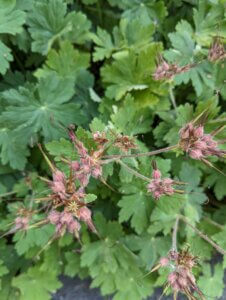
Flourishing in sun or light shade, big-root geraniums spread freely, but are not invasive. In the fall, the foliage turns a festive shade of red.
Geranium x cantabrigiense is a naturally occurring hybrid of big-root geranium and another species, Geranium dalmaticum, with a ground-covering habit. The leaves are dissected, but are smaller, more rounded and daintier than those of its relative. Shell-pink flowers accent the popular ‘Biokovo’ variety, appearing in the spring, with leaves that may redden in the fall.
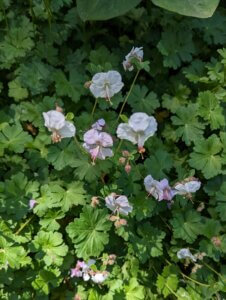
Scents of Thyme
Prostrate or creeping thyme (Thymus) plants make agreeable, often fragrant groundcovers in sunny spots, and are semi-evergreen in cold winter climates. In addition to tiny green or gray-green leaves, many varieties boast small, colorful flowers. Groundcover thymes are not generally used in cooking, unlike the closely related culinary thyme (Thymus vulgaris). Some gardeners use prostrate thyme plants in beds and borders, while others position them between stepping stones or on lightly traveled paths. Flowers may be white, pink or purple-pink, depending on species and variety, with most appearing in early summer. Among the most popular species are Thymus serpyllum or wild thyme; Thymus praecox; Thymus pseudolanguinosus, commonly known as “woolly thyme”, with softly hairy foliage; and Thymus herba-barona, or “caraway thyme”, which bears caraway-scented leaves that can be used in cooking.
All thymes like well drained soil and, once established, are drought-tolerant.

Hosta Minis
Hostas of all sizes and descriptions are loved for their shade tolerance, beauty, tenacity and ease of care. Small hostas also make great low groundcovers. At four to eight inches tall (with taller flower spikes), minis are available in a variety of colors and forms. The classic ‘Blue Mouse Ears’ features rounded, blue-green leaves, while its sport (spontaneous genetic mutation), ‘Mighty Mouse’ has the same foliage edged in cream. Light up dark places with ‘Munchkin Fire’, with pointed golden green leaves. Little ‘Lemon Zinger’ also bears pointed leaves with wavy edges and darker green leaf margins.
Happy hostas will multiply quickly into ground-covering clumps that can be easily divided in spring. The minis are as tough as their larger relatives and do well under trees and in other difficult situations. Provide consistent moisture during dry periods.
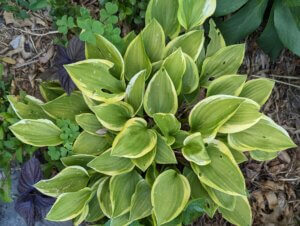
Sweets for the Shade
Another shade loving groundcover with great leaves is sweet woodruff (Gallium odoratum), sometimes called “sweet-scented bedstraw”. Each dark green leaf is lance-shaped, but the leaves are grouped in rounded, seven-leaf whorls that swirl about eight inches above the soil. In mid- spring, small clusters of four-petaled white flowers appear. Both flowers and leaves are fragrant, and can be dried and used in potpourri or sachets. Sweet woodruff spreads handily—sometimes a bit too handily—in its preferred moist, shaded environment, but escapee plants can be hand pulled or mowed easily. It will grow successfully under black walnut trees, a challenging location for many plants.
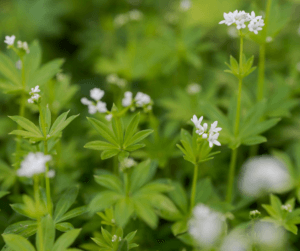
Bugleweed Trumpets
With its ground-hugging scallop-shaped leaves and bright blue spring flower spikes, ajuga (Ajuga reptans) attracts attention. In the species form, the leaves are shiny and dark green, but plant hybridizers have been busy creating varieties with more colorful foliage. ‘Black Scallop’, for example features darkest purple to black foliage, while ‘Burgundy Glow’ is variegated in cream, sometimes with rosy highlights. ‘Bronze Beauty’s’ leaves are bronze-red. All feature similar spikes of tiny blue flowers that attract spring pollinators. For something familiar, but just a bit different, vendors offer ‘Pink Lightening’, with pink-purple flower spikes.
Ajuga is great for covering areas that have varying mixtures of sun and shade, and prefers consistently moist soil.
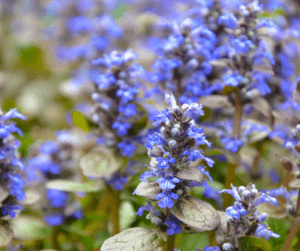
If you are covering a large area with any groundcover, start with small “plug” plants and space according to directions on the tags. Mulch around the new arrivals and water regularly. Eventually your little plants will spread to meet each other and take over the mulching duties on their own.


